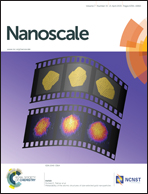Versatile method for AFM-tip functionalization with biomolecules: fishing a ligand by means of an in situ click reaction†
Abstract
A facile and universal method for the functionalization of an AFM tip has been developed for chemical force spectroscopy (CFS) studies of intermolecular interactions of biomolecules. A click reaction between tripod–acetylene and an azide–linker–ligand molecule was successfully carried out on the AFM tip surface and used for the CFS study of ligand–receptor interactions.


 Please wait while we load your content...
Please wait while we load your content...